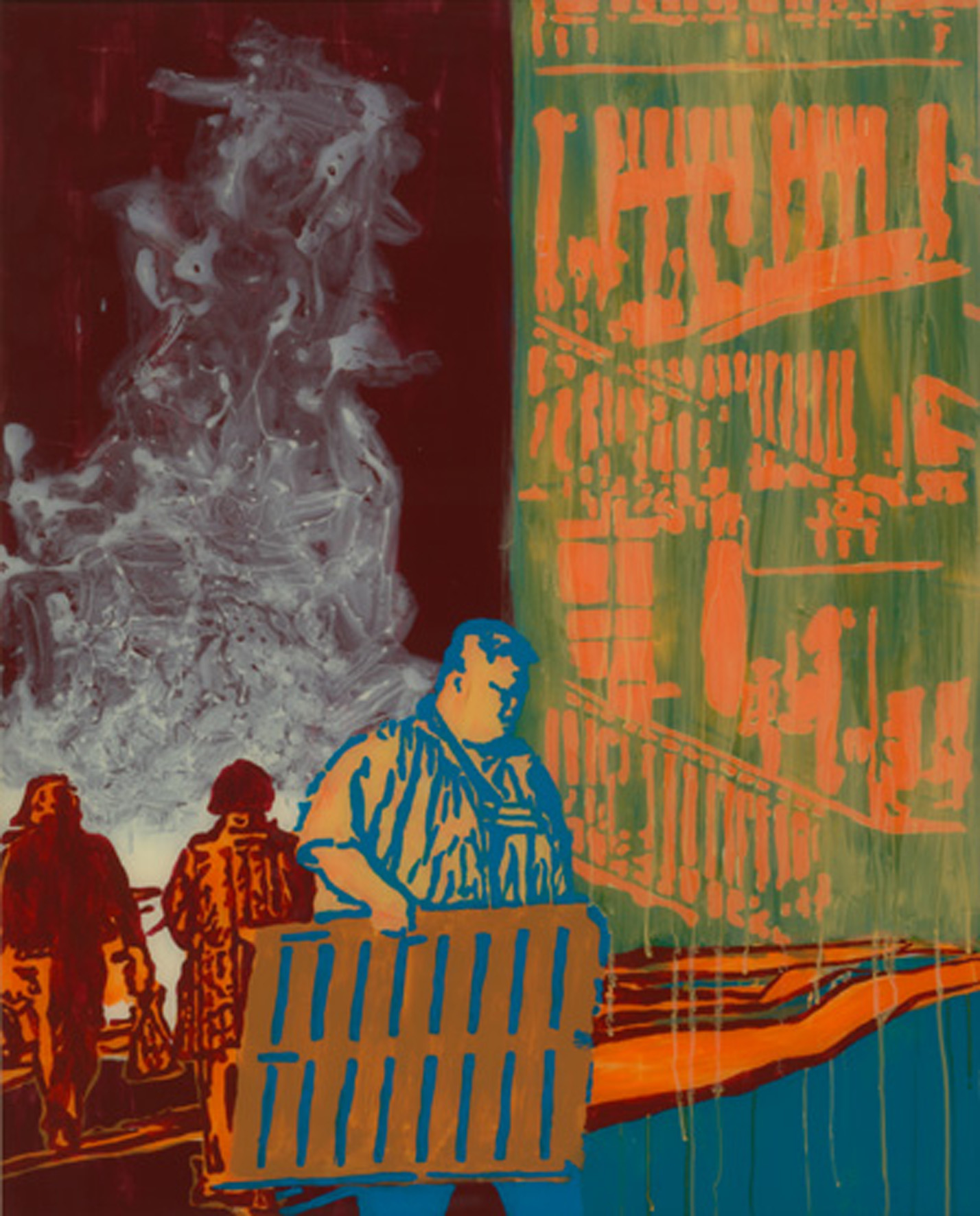| Andreas Weiland
THE 'NEW YORK SERIES' OF UTE HARING
When Ute Haring was working as a painter and lithographer
in New York (since November, 2001), history had just taken a sharp
turn. The economic, political, and military violence that US corporations,
the secret services of the United States and various US governments had
been bringing to the Third World, again and again, had returned with unimagined
terrorist vengeance. It was a brutal act, an absurd act, and it filled
many New Yorkers with anxiety if not horror. It spelled death for more
than 3,000 civilians, it brought doom to the tip of Manhattan, the self-proclamed
center of financial capital and a turbo-capitalism denying that frontiers
still mattered to its onslaught.
A first series of Sept. 11 etchings by Ute Haring I saw
(according to her, Radierung und Fotoradierung auf Eisen) captured a gloomy
atmosphere. Streetscapes like gorges, depressingly high skyscrapers flanking
sidewalks and one-way streets with hardly any cars and pedestrians. Everything
was clay-colored, as if covered by a thick layer of dust that had been
moistened by rain or tears and was sticking, as a thick, monochrome layer,
to a city frozen in shock.
I thought if there ever was a city of lemurs, hiding in
the empty hollows of these looming skyscrapers, it was right in front of
my eyes. The angst that was, like a spell, embracing Manhattan,
was omnipresent.
Now, I'm facing a second series of New York works. They
are paintings (acrylics, painted behind glass [mit Acryl hinter Glas gemalt]).
Their colors remind me of the Caribbean, of reggae, of
a world announced already by the colors of Garcia Marquez's Columbian dreams.
And yeah...........I sense the vibrations of Harlem jazz, I begin to hear
again the canned music echoing from the cabs of Haitian taxidrivers, my
eyes follow the movements of branches and leaves in the Central Park as
it is magically transformed by Christo's Japanese (or are they Korean?)
'gates,' I step into a tobacco store out of a movie by Wayne Wang,
I see Harvey Keitel and Mother Jones and the girls from Ipanema and the
other girls, from a sweatshop in Rivington Street. I walk down dead end
alleys in a Jewish neighborhood from out of 'Radio Days,' and the girls
giggle.
Manhattan, New York City, more than a center of financial
might, in a country famed for its post-World War II course of aggression,
more than a symbol of aggressive capitalism and US destructive greed and
ambition. Ute Haring discovers "the other side," the vital, vibrant, antagonistic
quality of a city of immigrants, a city tied to the old democratic vision,
tied to the old promise of "life, liberty, and the pursuit of happiness."
A promise betrayed again and again, as we all might know, and still it
hovers in the air. People believe in it, long for it to become true, are
drawn by it to this huge, lovely, terrible, all but class-less reality
of Manhattan, the Bronx, Queens, Flatbush, Stony Brooks, L.I. and you name
it...

Downtown Manhattan I
Smoke rising from a fire that may be warming the
homeless. Or that may serve to burn trash. Perhaps fresh oil has been applied
to potholes in the street, and it had to be warmed, giving rise to clouds
of smoke in the wintry New York climate. A workman seems to walk away,
with some object, in the foreground. Two pedestrians, ladies of perhaps
lowly immigrant background, walk away from us. Returning home, perhaps,
after having bought veggies at the grocery store nearby.
A scene of construction, or reconstruction, or of clearing
up the debris, after September 11? A scene embedded in the everyday lifes
of New Yorkers. The smoke rising makes childhood memories come to life.
Stories about witches and monsters rising with the smoke. The windows,
stairs in the background, the stout worker, this could be any big American
city, its down-to-earth, hefty reality. The calm, undisturned rhythm of
some one doing his job. The way two women walk home in the afternoon sun
while its strong colors paint patterns of sunlight and shadow on the boardwalk.
I'm in love with the colors of this city - the way Ute Haring makes it
come to life.
The weird distress of yesterday, today, tomorrow clashes
with the joy of ordinary lives that Whitman, that Carl Sandburg once sang
of. The colors of Jim Dine's tools. The red wheelbarrow of the Doc from
New Jersey who celebrated, who recreated Patterson in his poetry. The music
of America, of New York.
go
to next page
* |